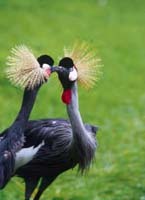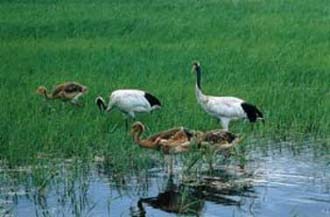|
|
|
Fauna and Flora
China
is one of the countries with the greatest diversity of wildlife
in the world. There are more than 4,400 species of vertebrates,
more than 10 percent of the world’s total. There are nearly 500
animal species, 1,189 species of birds, more than 320 species of
reptiles and 210 species of amphibians. Wildlife peculiar to China
includes such well-known animals as the giant panda, golden-haired
monkey, South China tiger,
brown-eared pheasant, white-flag dolphin, Chinese alligator and
red-crowned crane, totaling more than 100 species. The giant panda
is an especially attractive sight. Heavily built, it has a docile
disposition, and is delightfully adorable. The 1.2-m-tall red-crowned
crane is a snow-white migratory bird. A distinctive patch of red
skin tops its grey-brown head, hence its name. The white-flag dolphin
is one of only two species of freshwater whale in the world. In
1980, a male white-flag dolphin was caught for the first time in
the Yangtze River, which aroused great interest among dolphin researchers
worldwide.
|
The precious golden
camellia.

A giant panda with her cubs.
|
species
of arbor, is considered as one of the oldest and rarest plants in
the world. The golden larch, one of only five species of rare garden
trees in the world, grow in the mountain areas in the Yangtze River
valley. Its coin-shaped leaves on short branches are green in spring
and summer, turning yellow in autumn. China is home to more than 2,000
species of edible plants and 3,000 species of medicinal plants. Ginseng
from the Changbai Mountains, safflowers from Tibet, Chinese wolfberry
from Ningxia and notoginseng from Yunnan and Guizhou are particularly
well-known Chinese herbal medicines. There is a wide variety of flowering
plants. A flower indigenous to China, the elegant and graceful peony
is treasured as the “color of the nation and the scent of heaven.”
Three famous species of flowers--the azalea, fairy primrose and rough
gentian--grow in southwest China. During the flowering period, mountain
slopes covered with flowers in a riot of colors form a delightful
contrast with undulating ridges and peaks.
In
a concerted effort to protect the nation’s zoological and botanical
resources, and save species close to extinction, China has established
1.146 nature reserves to protect forests and wildlife, with a total
area of 88.13 million ha. The 15 nature reserves in China, namely,
Sichuan’s Wolong and Jiuzhaigou, Jilin’s Changbai Mountains, Guangdong’s
Dinghu Mountains, Guizhou’s Fanjing Mountains, Fujian’s Wuyi Mountains,
Hubei’s Shennongjia, Inner Mongolia’s Xilingol, Xinjiang’s Mt. Bogda,
Yunnan’s Xishuangbanna, Jiangsu’s Yancheng, Zhejiang’s Tianmu Mountains
Nanji and Islands Guizhou’s Maolan and Heilongjiang’s Fenglin, have
joined the “International People and Bio-sphere Protection Network.”
Heilongjiang’s Zhalong, Jilin’s Xianghai, Hunan’s Dongting Lake,
Jiangxi’s Poyang Lake, Qinghai’s Bird Island, Hainan’s Dongzhai
Harbor and Hong Kong’s Mai Po have been included in the listing
of the world’s important wetlands.
|

Northeast
China Tiger. |
 Crested
cranes.
Crested
cranes.
|
|

Zhalong Natural
Protection Zone--the home of red-crown crane.
|
|



